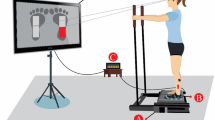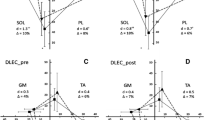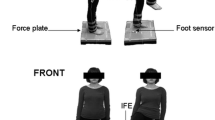Abstract
The aim of this study was to determine whether and how young participants modulate their postural response to compensate for postural muscle fatigue during predictable but externally initiated continuous and oscillatory perturbations. Twelve participants performed ten postural trials before and after an ankle muscle fatigue protocol. Each postural trial was 1 min long and consisted of continuous backward and forward oscillations of the platform. Fatigue was induced by intermittent, bilateral isometric contractions of the ankle plantar- and dorsiflexors until the force production was reduced to 50 % of the pre-fatigue maximal voluntary contraction. Changes in the center of mass (COM) displacement, center of pressure (COP) displacement, and anterior–posterior location of the COP within the base of support were quantified as well as the activity of the tibialis anterior (TA), medial gastrocnemius (MG), quadriceps, and hamstring. All participants demonstrated postural stability post-fatigue by maintaining the displacement of their COM. Everyone also demonstrated a general forward shift in the anterior–posterior location of the COP within the base of support; however, two distinct postural modifications, corresponding to either an immediate fatigue-induced increase or decrease in the COP displacement during the backward platform translation, were recorded immediately post-fatigue. The changes in muscle onset latencies lasted beyond the recovery of the force production of the fatigued postural muscles. By 10 min post-fatigue, the participants showed a decrease in the COP displacement as well as an earlier activation of the postural muscles and an increased TA/MG co-activation relative to pre-fatigue. Although different strategies were used, the participants were able to adjust to and overcome postural muscle fatigue and remain balanced during the postural perturbations regardless of the direction of the platform movement. These adjustments lasted beyond the recovery of the ankle muscle force production indicating that they may be part of a centrally mediated protective response as opposed to a peripherally induced limitation to performance.




Similar content being viewed by others
References
Adkin AL, Frank JS, Carpenter MG, Peysar GW (2000) Postural control is scaled to level of postural threat. Gait Posture 12:87–93
Amann M, Dempsey JA (2008) Locomotor muscle fatigue modifies central motor drive in healthy humans and imposes a limitation to exercise performance. J Physiol 586:161–173
Benvenuti F, Stanhope SJ, Thomas SL, Panzer VP, Hallett M (1997) Flexibility of anticipatory postural adjustments revealed by self-paced and reaction-time arm movements. Brain Res 761:59–70
Bouisset S, Zattara M (1987) Biomechanical study of the programming of anticipatory postural adjustments associated with voluntary movement. J Biomech 20:735–742
Bugnariu N, Fung J (2007) Aging and selective sensorimotor strategies in the regulation of unright balance. J NeuroEng Rehabil 4:19
Bugnariu N, Sveistrup H (2006) Age-related changes in postural responses to externally- and self-triggered continuous perturbations. Arch Geron Geriat 42:73–89
Carpenter MG, Frank JS, Adkin AL, Paton A, Allum JHJ (2004) Influence of postural anxiety on postural reactions to multi-directional surface rotations. J Neurophysiol 92:3255–3265
Davidson BS, Madigan ML, Nussbaum MA, Wojcik LA (2009) Effects of localized muscle fatigue on recovery from a postural perturbation without stepping. Gait Posture 29:552–557
Dietz V, Trippel M, Ibrahim IK, Berger W (1993) Human stance on a sinusoidally translating platform: balance control by feedforward and feedback mechanisms. Exp Brain Res 93:352–362
Enoka RM, Duchateau J (2008) Muscle fatigue: what, why and how it influences muscle function. J Physiol 586:11–23
Fox ZG, Mihalik JP, Blackburn T, Battaglini CL, Guskiewicz KM (2008) Return of postural control to baseline after anaerobic and aerobic exercise protocols. J Athl Train 43:456–463
Goble DJ, Coxon JP, Wenderoth N, Van Impe S, Swinnen SP (2009) Proprioceptive sensibility in the elderly: degeneration, functional consequences and plastic-adaptive processes. Neursci Biobehav R 33:271–278
Hermens H, Freriks B, Disselhorst-Klug C, Rau G (2000) Development of recommendations for SEMG sensors and sensor placement procedures. J Electromogr Kinesiol 10:361–375
Horak F (2006) Postural orientation and equilibrium: what do we need to know about neural control of balance to prevent falls? Age Aging 32:ii7–ii11
Horak FB, Diener HC, Nashner LM (1989) Influence of central set on human postural responses. J Neurophysiol 62:841–853
Hughey LK, Fung J (2005) Postural response triggered by multidirectional leg lifts and surface tilts. Exp Brain Res 165:152–166
Johnston RB, Howard ME, Cawley PW, Losse GM (1998) Effect of lower extremity muscular fatigue on motor control performance. Med Sci Sports Exe 30:1703–1707
Kanekar N, Santos MJ, Aruin AS (2008) Anticipatory postural control following fatigue of postural and focal muscles. Clin Neurophysiol 119:2304–2313
Kennedy A, Hug F, Bilodeau M, Sveistrup H, Guével A (2011a) Neuromuscular fatigue induced by alternating isometric contractions of the ankle plantar and dorsiflexors. J Electromyogr Kinesiol 21:471–477
Kennedy A, Sveistrup H, Guével A (2011b) Habituation to unexpected postural perturbations. In: Society for Neuroscience, vol 812, Washington, DC, p 5
Kuo AD, Zajac FE (1993) A biomechanical analysis of muscle strength as a limiting factor in standing posture. J Biomech 26:137–150
Laughton CA, Slavin M, Katdare K et al (2003) Aging, muscle activity, and balance control: physiologic changes associated with balance impairment. Gait Posture 18:101–108
Mahyar S, Mojgan M, Ismaeil E, Amir Massoud A (2007) Changes in postural stability with fatigue of lower extremity frontal and sagittal plane movers. Gait Posture 26:214–218
Nardone A, Tarantola J, Galante M, Schieppati M (1998) Time course of stabilometric changes after a strenuous treadmill exercise. Arch Phys Med Rehabil 79:920–924
Nardone A, Galante M, Pareyson D, Schieppati M (2007) Balance control in sensory neuron disease. Clin Neurophysiol 118:538–550
Noakes TD, St Clair Gibson A, Lambert EV (2005) From catastrophe to complexity: a novel model of integrative central neural regulation of effort and fatigue during exercise in humans: summary and conclusions. Br J Sports Med 39:120–124
Okada S, Hirakawa K, Takada Y, Kinoshita H (2001) Relationship between fear of falling and balancing ability during abrupt deceleration in aging women having similar habitual physical activities. Eur J Appl Physiol 85:501–506
Pline KM, Madigan ML, Nussbaum MA (2006) Influence of fatigue time and level on increases in postural sway. Ergonomics 49:1639–1648
Riccio GE, Stoffregen TA (1988) Affordances as constraints on the control of stance. Hum Mov Sci 7:265–300
Riley MA, Stoffregen TA, Grocki MJ, Turvey MT (1999) Postural stabilization for the control of touching. Hum Mov Sci 18:795–817
Santos MJ, Kanekar N, Aruin AS (2010) The role of anticipatory postural adjustments in compensatory control of posture: 2. Biomechanical analysis. J Electromyogr Kinesiol 20:398–405
Schmid M, Bottaro A, Sozzi S, Schieppati M (2011) Adaptation to continuous perturbation of balance: progressive reduction of postural muscle activity with invariant or increasing oscillations of the center of mass depending on perturbation frequency and vision conditions. Hum Mov Sci 30:262–278
Scholz JP, Schoner G, Hsu WI, Jeka JJ, Horak F, Martin V (2007) Motor equivalent control of the center of mass in response to support surface perturbations. Exp Brain Res 180:163–179
Seilder RD, Bernard JA, Burutolu TB, Gordon JT, Gwin JT, Kwak Y, Lipps D (2010) Motor control and aging: links to age-related brain structural, functional, and biochemical effects. Neurosci Biobehav Rev 34:721–733
Shiratori T, Latash ML (2001) Anticipatory postural adjustments during load catching by standing subjects. Clin Neurophysiol 112:1250–1265
Shumway-Cook A, Woollacott M (2007) Motor control: translating research into clinical practice. Lippincott Williams & Wilkins, Washington, DC
Stoffregen TA, Pagulayan RJ, Bardy BG, Hettinger LJ (2000) Modulating postural control to facilitate visual performance. Hum Mov Sci 19:203–220
Strang AJ, Berg WB (2007) Fatigue-induced adaptive changes of anticipatory postural adjustments. Exp Brain Res 178:49–61
Strang AJ, Choi HJ, Berg WP (2008) The effect of exhausting aerobic activity on the timing of anticipatory postural adjustments. J Sports Med Phys Fit 48:9–16
Strang AJ, Berg WP, Hieronymus M (2009) Fatigue-induced early onset of anticipatory postural adjustments in non-fatigued muscles: support for a centrally mediated adaptation. Exp Brain Res 197:245–254
TCPS2 (2010) Tri-council policy statement: Ethical conduct for research involving humans. Canadian Institutes of Health Research, Natural Science and Engineering Research Council of Canada, and Social Sciences and Humanities Research Council of Canada
Thelen E, Spencer JP (1998) Postural control during reaching in young infants: a dynamic systems approach. Neurosci Biobehav R 22:507–514
van der Heide JC, Otten B, van Eykern LA, Hadders-Algra M (2003) Development of postural adjustments during reaching in sitting children. Exp Brain Res 151:32–45. doi:10.1007/s00221-003-1451-3
Vincent WJ (2005) Statistics in kinesiology. Human Kinetics, Champaign
Vuillerme N, Nougier V, Teasdale N (2002) Effects of lower limbs muscular fatigue on anticipatory postural adjustments during arm motions in humans. J Sports Med Phys Fitness 42:289–294
Wilson E, Madigan M, Davidson B, Nussbaum M (2006) Postural strategy changes with fatigue of the lumbar extensor muscles. Gait Posture 23:348–354
Wilson ML, Rome K, Hodgson D, Ball P (2008) Effect of textured foot orthotics on static and dynamic postural stability in middle-aged females. Gait Posture 27:36–42
Yaggie JA, McGregor SJ (2002) Effects of isokinetic ankle fatigue on the maintenance of balance and postural limits. Arch Phys Med Rehabil 83:224–228
Author information
Authors and Affiliations
Corresponding author
Rights and permissions
About this article
Cite this article
Kennedy, A., Guevel, A. & Sveistrup, H. Impact of ankle muscle fatigue and recovery on the anticipatory postural adjustments to externally initiated perturbations in dynamic postural control. Exp Brain Res 223, 553–562 (2012). https://doi.org/10.1007/s00221-012-3282-6
Received:
Accepted:
Published:
Issue Date:
DOI: https://doi.org/10.1007/s00221-012-3282-6




